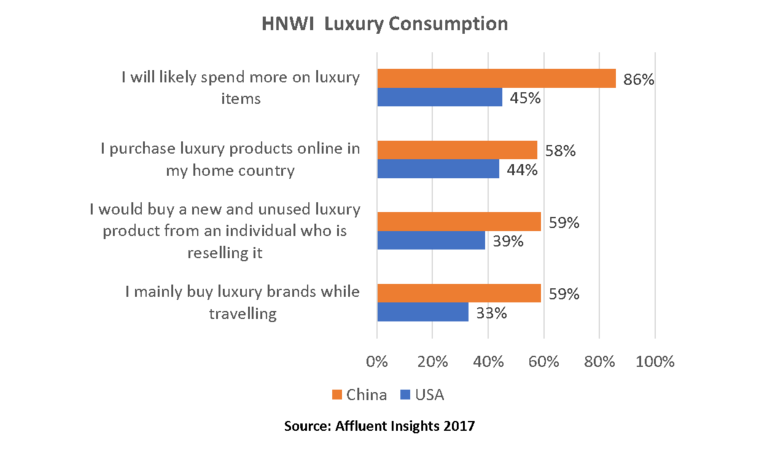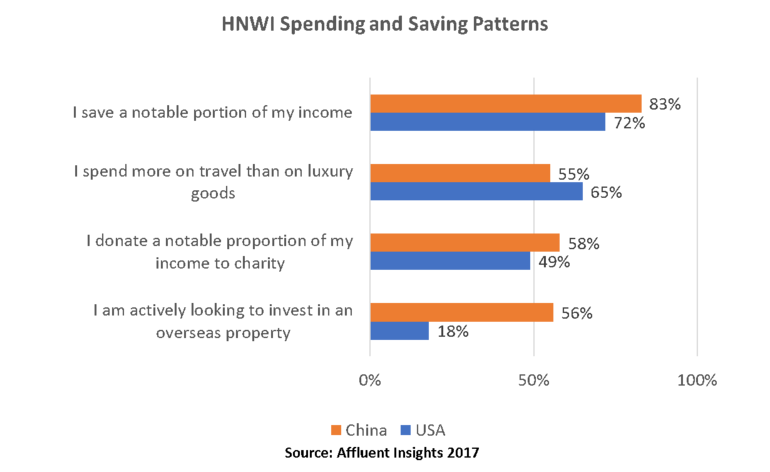Culture in money
Though the rich in these nations have benefited from the rise in the economic growth in their respective countries, a more central factor to their wealth stems from the cultures they have been brought up in.
- In China, wealth accumulation practices, hard work ethics and striving for a better life have been ingrained in the Chinese psyche.
- In the United States, the spirit of the “American Dream,” the desire to succeed in life through hard work and entrepreneurship, and the belief of an equal opportunity for all, has been embodied by many Americans since the nation came into being.
Shift in changing patterns
While most cultures and traditions remain, the wealthy’s spending patterns have definitely changed.
- For example, the Chinese are spending more and becoming more globalised in their spending choices, following the political and cultural opening of the PRC economy, contributing 30% to global personal luxury goods sales last year — a figure risen from a small 3% in 2007.
- On the other hand, different economic sources state that Americans are spending less after the wake of 2008 financial crisis and that they are saving more than they are spending, with statistics showing that though Americans contributed 34% to global personal luxury goods sales in 2007, last year they only accounted for 23%.
Luxury Consumption
There is a gaping 41% difference between Chinese HNWIs (86%), and American HNWIs (45%), in terms of future aspiration to buying luxury items, which showcases the extent of the differences between the appetite of consumers in these two markets.
Similarly, Chinese HNWIs are far more likely than American HNWIs to prefer purchasing luxury products online, while they are travelling, and are much more willing to buy luxury items from the grey market.
Spending and Saving Patterns
The majority of HNWIs in both China and the US follow similar trends — saving a notable portion of their income, spending more on travel than on luxury goods and even donating a notable portion of their income to charity.
Surprisingly though only 18% of American HNWIs are actively looking to invest in overseas property, as compared to a whole 56% of Chinese HMWIs.
American HNWIs contribute more to luxury sales than Chinese
A data analysis by Luxury Society uncovers that American HNWIs had contributed US$14.4 billion last year to luxury goods purchases globally (including: luxury fashion, jewellery, and watches).
In comparison, Chinese HNWIs contributed US$9.5 billion.
Also in their local areas respectively,
- Chinese HNWIs contributed 12% of sales by Chinese personal luxury goods consumers.
- On the other hand, American HNWIs contributed to 24% of sales by American personal luxury goods consumers, a major difference in the demographic makeup of luxury consumers.
This is a crucial insight for brands that they need to pay attention to when building their strategies in these two different markets.
What does this mean for brands?
At this rate, it will be a likely fact that China will take the number 1 spot in the global economy in terms of Purchasing Power Parity by 2030, with the US which will move down to the number 2 spot.
Due to China’s population size and growing economy, Chinese consumers will undoubtedly be the main consumers of luxury goods in the future, trumping the spending by American consumers by the billions.
What this means is that in order to boost the American luxury goods market, brands need to either start focusing more on:
- attracting the American non-HNWIs to purchase more luxury goods
- boosting the sales of luxury goods among American HNWIs
- developing a range of products that are still luxury but in more affordable price ranges.
Nevertheless, one particular challenge remains: there is a a pro-saving sentiment gaining ground in the United States, and this is an overall broader issue for luxury brands to address. Perhaps one option is increasing their appeal to non-American visitors and tourists to boost up demand.
If you enjoyed reading this and would like to read more luxury related content, feel free to take a look at our Luxury Case Studies Library!








